We’ve all stared at that boring fence line wondering how to transform it from an eyesore into a stunning industry feature. Whether you’re dealing with privacy concerns or simply want to add natural beauty to your property boundary, choosing the right plants can make all the difference.
The secret lies in selecting plants that thrive along fence lines while serving multiple purposes. We’re talking about creating living walls that offer privacy, attract wildlife, and add year-round interest to your outdoor space. From fast-growing evergreens to colorful flowering shrubs, the possibilities are endless.
Getting your fence line planting right isn’t just about picking pretty plants – it’s about understanding which varieties will flourish in these unique growing conditions. We’ll guide you through the best options that’ll turn your fence from forgotten to fabulous, creating the perfect backdrop for your garden while boosting your home’s curb appeal.
Fast-Growing Vines That Transform Your Fence Line
Vines offer the quickest solution for creating an impressive fence line transformation that delivers dramatic results within just one growing season.
Clematis for Colorful Seasonal Blooms
Clematis vines produce stunning flowers in purple, pink, white, and red varieties that bloom from spring through fall depending on the cultivar you choose. We recommend planting these climbing beauties in locations where their roots stay cool but their tops reach full sunlight for optimal flowering performance. These vigorous growers can reach heights of 6 to 20 feet and create spectacular vertical displays along fence structures.
Popular clematis varieties like ‘Jackmanii’ and ‘Henryi’ establish quickly and provide years of reliable blooms that attract butterflies and hummingbirds to your fence line garden. Plant clematis vines 3 feet apart along your fence to ensure adequate spacing for mature growth while creating continuous coverage.
Virginia Creeper for Dense Coverage
Virginia creeper delivers the fastest coverage solution available for fence lines with growth rates reaching up to 10 feet per year in ideal conditions. This native climbing vine produces dense foliage that turns brilliant red and orange in fall, creating a stunning seasonal display that transforms any ordinary fence into a living wall of color.
We’ve found Virginia creeper thrives in almost any soil condition and tolerates both full sun and partial shade environments better than most other vine options. The plant’s adhesive tendrils allow it to climb virtually any fence material including wood, vinyl, chain link, and metal without requiring additional support structures.
This hardy vine requires minimal maintenance once established and provides excellent wildlife habitat for birds and beneficial insects throughout the growing season.
Honeysuckle for Fragrant Appeal
Honeysuckle vines create an enchanting sensory experience along fence lines with their intensely fragrant tubular flowers that bloom from late spring through summer months. We particularly love varieties like ‘Goldflame’ and ‘Dropmore Scarlet’ that produce vibrant red, orange, and yellow blooms while maintaining vigorous growth habits that quickly cover fence structures.
These fast growing vines can extend 15 to 20 feet in a single season and attract hummingbirds, butterflies, and beneficial pollinators that enhance your garden’s network. Plant honeysuckle varieties 4 to 6 feet apart along your fence line to allow proper air circulation while ensuring complete coverage within two growing seasons.
Native honeysuckle species offer the best performance and environmental benefits compared to invasive varieties, making them the smart choice for sustainable fence line landscaping projects.
Evergreen Shrubs for Year-Round Privacy
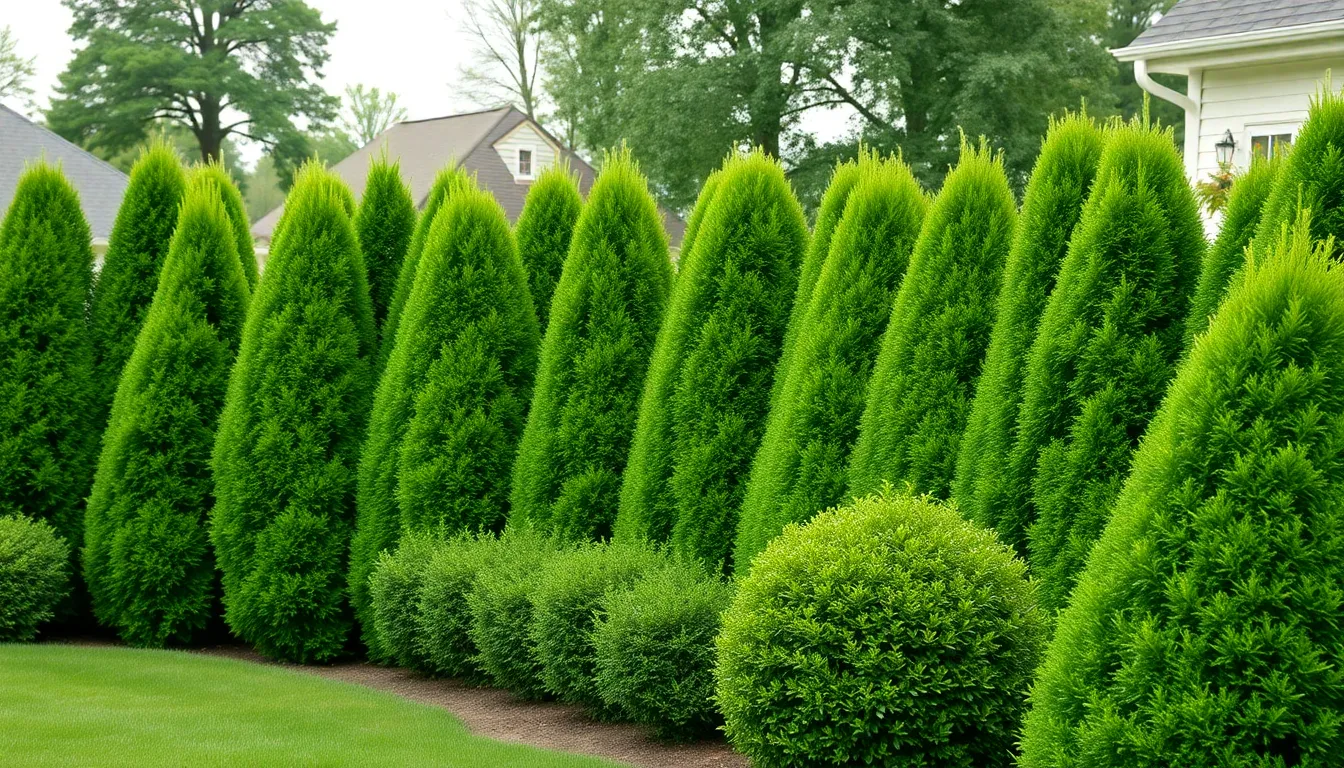
Evergreen shrubs maintain their foliage throughout all seasons, providing consistent privacy and aesthetic appeal along fence lines. These plants create lush, dense privacy screens that effectively block views and reduce noise while improving your garden’s visual interest.
Arborvitae for Tall Screening
Arborvitae stands out as one of the most effective shrubs for creating tall privacy hedges along fence lines. Popular varieties like Emerald Green, North Pole®, and Polar Gold® feature narrow, pyramidal shapes with dense evergreen foliage that retains its vibrant color through winter months.
Growth characteristics make arborvitae particularly appealing for homeowners seeking quick results. The ‘American Pillar’ cultivar grows up to 2 feet annually, reaching heights of 15-20 feet tall and approximately 4-5 feet wide at maturity. Green Giant Arborvitae offers similarly rapid growth rates, making it ideal for large screening projects.
Maintenance requirements remain minimal once these shrubs establish themselves in full sun locations. They tolerate heat and drought conditions effectively, thriving in various soil types while providing consistent year-round coverage for your fence line privacy needs.
Boxwood for Formal Borders
Boxwood creates elegant, structured borders that define fence lines with classic sophistication. Dense evergreen foliage responds beautifully to pruning, allowing you to shape these shrubs into neat, compact hedges that maintain their form throughout the year.
Formal garden settings benefit significantly from boxwood’s naturally tidy growth habit. These shrubs convey a polished, traditional appearance that complements both contemporary and classic industry designs along property boundaries.
Versatility in design applications makes boxwood suitable for various fence line configurations. Whether you’re creating low borders or medium-height screens, these shrubs adapt to your exact spacing and height requirements while maintaining their refined appearance.
Holly for Natural Security
Holly shrubs provide dual benefits by combining privacy screening with natural security features. Oak Leaf™ Red Holly grows up to 14 feet tall with dense, thorny branches that create an effective barrier while maintaining an attractive pyramidal form.
Seasonal interest enhances holly’s appeal beyond its security functions. Glossy evergreen leaves provide year-round structure, while bright berries persist through winter months, adding color when other plants lose their vibrancy.
Wildlife benefits make holly an environmentally conscious choice for fence line plantings. These shrubs support local ecosystems by providing habitat and food sources for birds, creating a living fence that serves multiple purposes in your industry design.
Flowering Perennials That Beautify Fence Borders
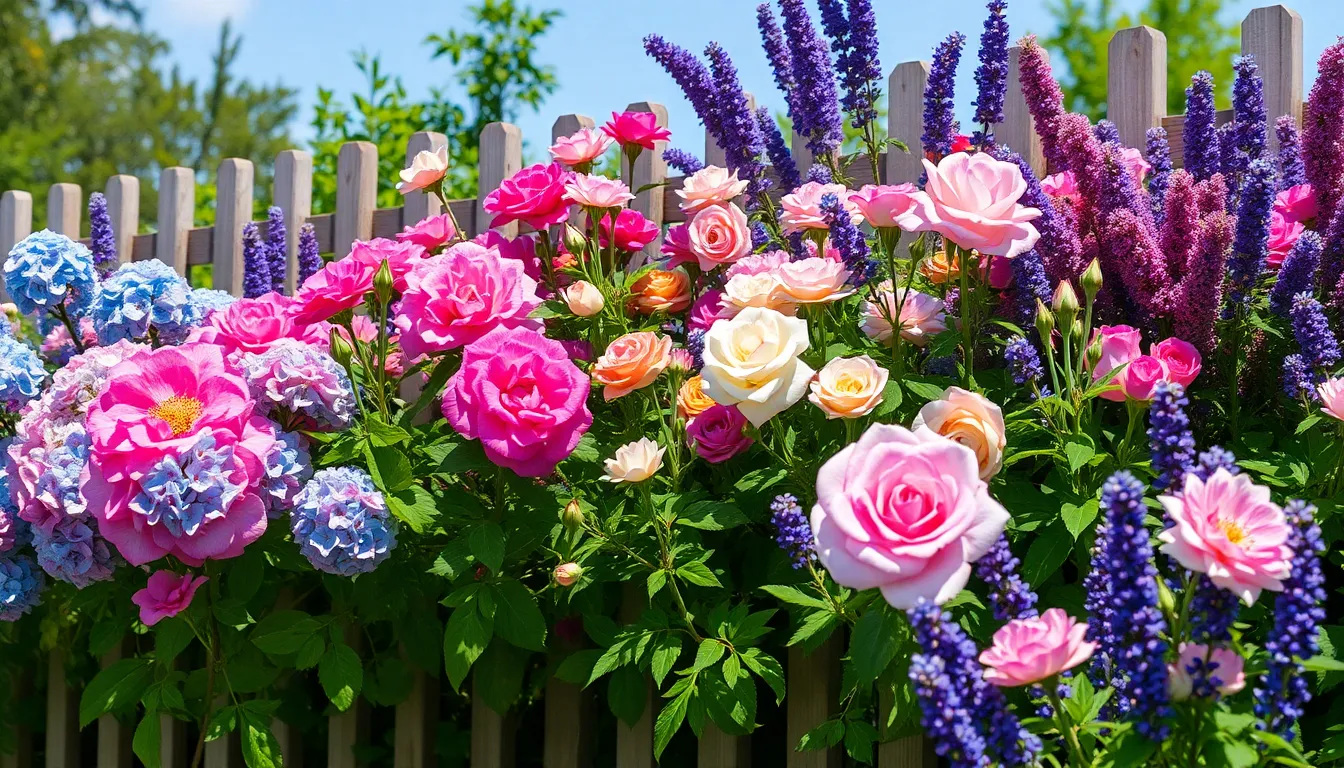
Flowering perennials offer the perfect combination of lasting structure and seasonal color for fence line borders. We can create stunning displays that bloom throughout the growing season by selecting plants with different textures, heights, and bloom times.
Hydrangeas for Bold Summer Color
Hydrangeas deliver spectacular visual impact with their large, showy flower heads that bloom from summer through fall. These versatile shrubs produce blooms in white, pink, blue, or purple, creating bold splashes of color along fence borders. Dense growth habits provide excellent privacy screening while offering a substantial green backdrop when flowers aren’t present.
Rich, well-draining soil helps hydrangeas thrive in partial sun conditions, making them adaptable to various fence line locations. Their mature size requires adequate spacing, but the dramatic flower displays make them worth the investment. We recommend planning for their substantial presence when designing your fence line garden.
Roses for Classic Romance
Roses bring timeless elegance and intoxicating fragrance to fence borders with their striking pink and red blooms. Shrub roses and climbing varieties work particularly well along fences, offering compact growth habits that fit beautifully in border plantings. Many varieties bloom continuously throughout summer, providing consistent color and scent.
Combining roses with other perennials creates layered, romantic fence line displays that capture attention throughout the growing season. Their classic appeal never goes out of style, and the added fragrance enhances the sensory experience of your outdoor space. We find that roses serve as excellent anchor plants around which to build the rest of your fence border design.
Lavender for Aromatic Gardens
Lavender contributes silver-green foliage, purple flower spikes, and delightful aromatics that make fence lines truly special. This drought-tolerant perennial thrives in full sun with well-draining soil, requiring minimal maintenance once established. Purple flowers create beautiful color contrasts when paired with roses or hydrangeas.
Pollinators flock to lavender’s fragrant blooms, supporting beneficial insects while adding movement and life to your fence border. Compact growth habits make lavender easy to incorporate into existing plantings without overwhelming other plants. We appreciate how lavender’s year-round structure provides consistent visual interest even when not in bloom.
Low-Maintenance Ground Cover Options
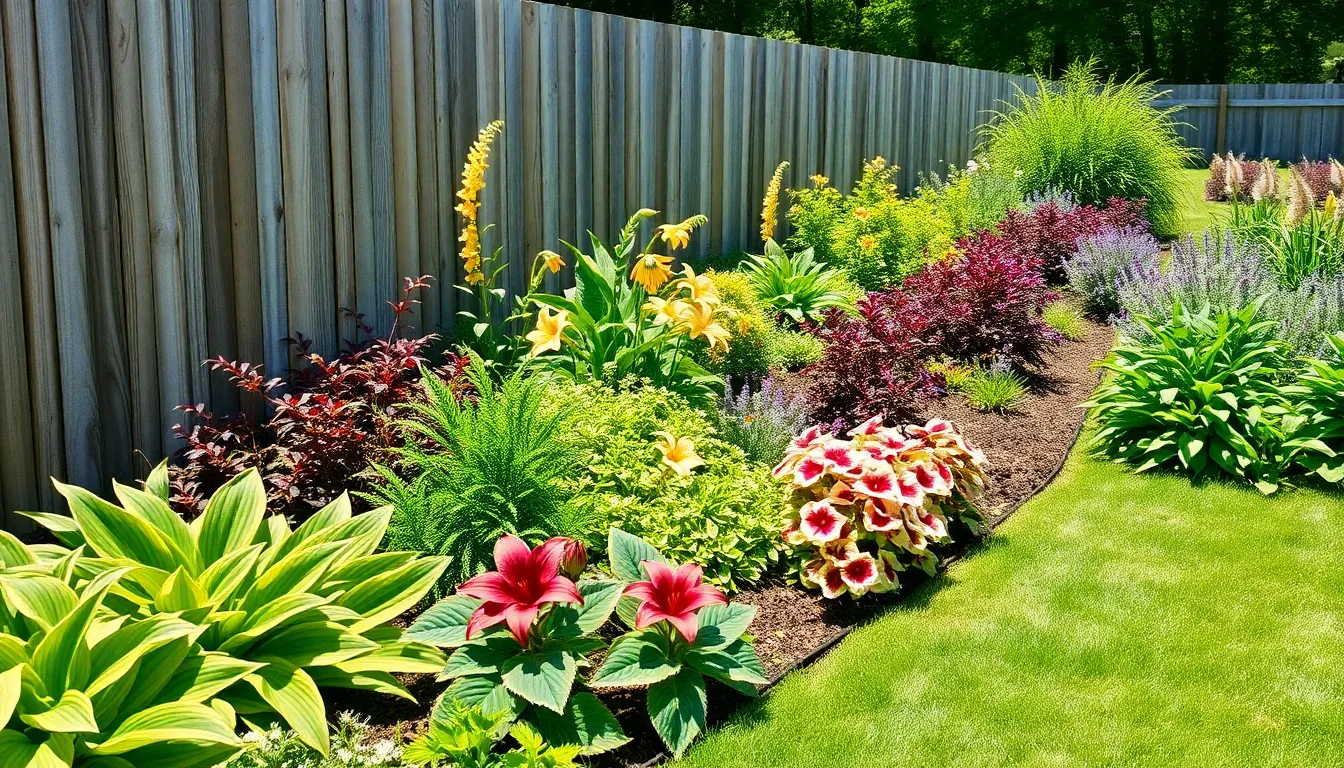
Ground cover plants offer the perfect solution for creating beautiful fence line borders without the constant upkeep of traditional landscaping. These hardy selections thrive with minimal care while providing continuous coverage throughout the growing season.
Hostas for Shaded Fence Lines
Hostas excel in shaded fence areas where other plants struggle to establish themselves. Their tolerance for low light conditions makes them ideal for north-facing fences or areas blocked by tall structures. We recommend hostas for their diverse leaf shapes and colors that add textural interest to darker spaces along your property line.
These perennials require only occasional watering and annual mulching to maintain their lush appearance. Their attractive foliage creates a substantial ground cover that fills spaces effectively while suppressing weed growth naturally.
Daylilies for Sunny Exposures
Daylilies thrive in full sun conditions where they produce bright, attractive summer flowers. These hardy perennials spread efficiently to cover ground along sunny fence lines with minimal maintenance requirements. Their foliage remains attractive throughout the growing season even when blooms aren’t present.
We’ve found daylilies particularly valuable for their ability to establish quickly and create dense coverage that helps prevent weeds. They handle drought conditions well once established and continue to multiply year after year.
Pachysandra for Dense Carpeting
Pachysandra forms exceptionally dense carpeting that creates thick mats along shaded fence lines. This evergreen ground cover spreads steadily to suppress weeds while requiring only occasional watering and light pruning. We recommend pachysandra for areas beneath trees or along shaded fence sections where you need consistent year-round coverage.
Its ability to thrive in shade to partial shade makes it perfect for challenging areas where other plants fail. The dense mat formation provides excellent erosion control while maintaining an attractive, uniform appearance with minimal care requirements.
Edible Plants for Fence Line Gardens
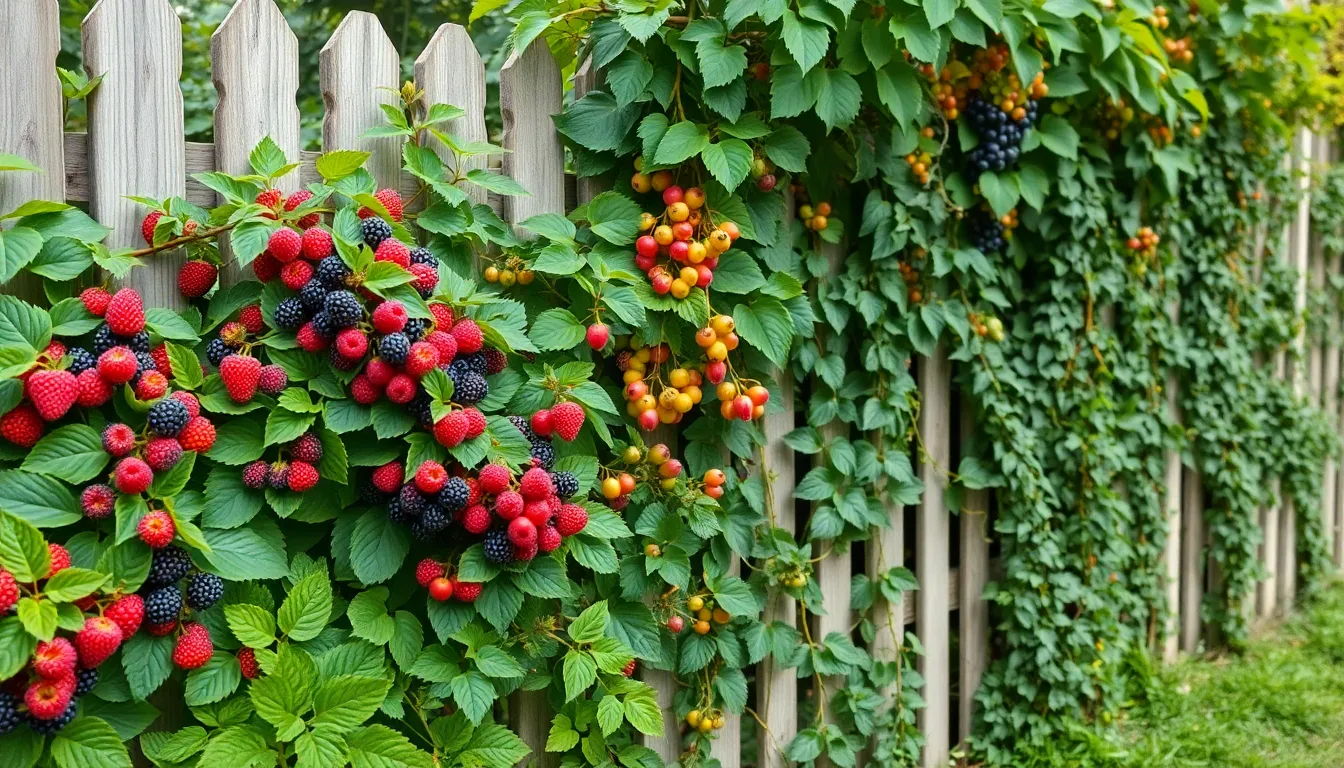
Transforming your fence line into an edible industry combines beauty with functionality, creating a productive space that provides fresh ingredients while improving your property’s appeal. This approach, known as foodscaping, integrates food-producing plants into decorative garden spaces, offering both aesthetic value and practical benefits.
Berry Bushes for Productive Landscaping
Red and black currants serve as excellent foundational hedge plants along fence lines, offering shade tolerance and easy maintenance while producing attractive berries and fragrant foliage. These versatile bushes create natural privacy screens while providing fresh fruit for jams, jellies, and baking throughout the growing season.
Black raspberries excel in fence line applications due to their clumping growth habit that prevents unwanted spreading, colorful winter canes that add visual interest, spring flowers that attract pollinators, and summer berries perfect for fresh eating. Their shade tolerance makes them ideal for areas where other fruit plants might struggle.
Blueberries, raspberries, and blackberries can effectively replace traditional ornamental shrubs along fence borders, delivering fresh berries for snacking and cooking while maintaining an attractive industry appearance. These productive plants offer seasonal interest through flowering, fruiting, and fall color changes.
Additional berry options include bush cherry for early season fruit, gooseberry for tart cooking berries, Rugosa rose with edible hips rich in vitamin C, and Aronia berries known as nutrient-dense superfoods that support wildlife.
Grape Vines for Vertical Growing
Grape vines maximize vertical space along fence lines, making them perfect for properties with limited growing area while providing both fruit production and natural shade. These climbing plants thrive when trained on fence structures or trellises, creating living screens that offer privacy and seasonal beauty.
Vertical growing advantages include efficient use of fence height, reduced ground space requirements, improved air circulation around plants, and easier harvesting when properly trained. Grape vines also provide dense coverage during growing season and attractive woody structure during dormant periods.
Seasonal benefits extend beyond fruit production, as grape vines offer spring growth excitement, summer shade creation, fall harvest opportunities, and winter architectural interest through their trained branching patterns.
Herb Gardens for Culinary Use
Low-growing herbs create excellent ground cover along fence bases, combining visual appeal with practical culinary applications while requiring minimal maintenance once established. Thyme, oregano, and creeping rosemary spread naturally along fence lines, offering drought resistance and tiny flowers that attract beneficial insects.
Fragrant herb varieties like lavender, sage, mint, and anise hyssop add color, texture, and delightful scents to fence line gardens while providing fresh ingredients for cooking and herbal teas. Anise hyssop stands out with its violet flower spikes and anise-scented leaves perfect for both teas and savory dishes.
Drought-resistant options thrive in fence line conditions where irrigation might be challenging, making them ideal for sustainable industry design that requires less water input while providing consistent harvests throughout the growing season.
Culinary integration becomes effortless when herbs grow just steps from your kitchen, encouraging regular use of fresh ingredients and reducing grocery costs while adding homegrown flavors to everyday meals.
Native Plants That Thrive Along Fence Lines
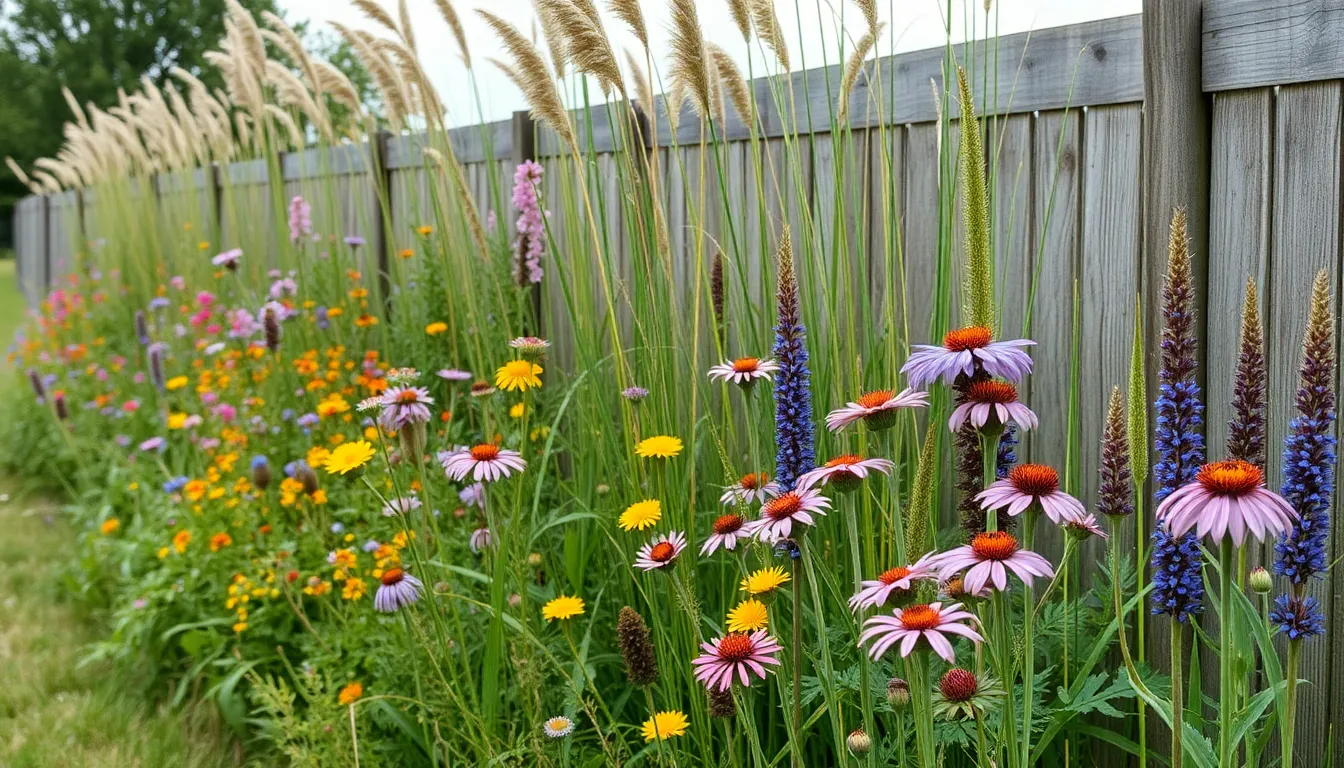
Native plants offer the perfect solution for fence line landscaping because they’re naturally adapted to local conditions and require minimal maintenance once established. We’ll explore three categories of native plants that excel in fence line applications.
Regional Wildflowers for Natural Beauty
Wildflowers native to your region create stunning seasonal displays while supporting local ecosystems along fence borders. Blue-eyed grass (Syrinchium angustifolium) produces delicate blue flowers that complement any fence line design with its grass-like foliage. Lyreleaf sage (Salvia lyrata) offers beautiful purple flower spikes that attract beneficial pollinators throughout the growing season.
Spiderwort (Tradescantia virginiana) delivers vibrant three-petaled flowers in shades of blue, purple, or white from spring through summer. American germander (Teucrium canadense) provides dense, low-growing coverage with aromatic foliage and small pink or white flowers. Purple coneflower (Echinacea purpurea) stands tall with its distinctive daisy-like blooms that attract butterflies and goldfinches.
Native violets (Viola sororia) carpet shaded fence areas with heart-shaped leaves and cheerful purple or white flowers in early spring. These wildflowers thrive in underused border areas where traditional plants might struggle, adding both biodiversity and visual appeal to your property.
Indigenous Grasses for Erosion Control
Native grasses provide excellent erosion control along fence lines while creating natural habitat for wildlife. Broomsedge bluestem (Andropogon virginicus) forms attractive clumps that turn golden bronze in fall, requiring minimal maintenance once established. This hardy grass adapts to various soil types and tolerates both wet and dry conditions.
Bottlebrush grass (Elymus hystrix) creates elegant vertical interest with its distinctive seed heads that resemble bottle brushes. The grass performs well in partial shade and helps stabilize slopes or areas prone to erosion. Both species complement wildflower plantings beautifully, creating a naturalized fence line network.
These indigenous grasses establish deep root systems that prevent soil erosion while providing year-round structure to your industry. They require no fertilizers or pesticides, making them environmentally friendly choices for sustainable fence line management.
Local Shrubs for Wildlife Habitat
Native shrubs along fence lines create essential wildlife corridors while providing natural privacy screening. Mahonia (Oregon grape) produces holly-like foliage with clusters of bright yellow flowers followed by blue-black berries that birds love. This versatile shrub tolerates various light conditions and requires minimal water once established.
Malosma laurina functions as an excellent windbreak or privacy screen with its dense branching pattern and evergreen foliage. The shrub produces small white flowers that attract beneficial insects, followed by reddish berries that provide food for local wildlife. It thrives in sandy or clay soils with minimal irrigation after the establishment period.
These native shrubs typically require careful soil selection, as some species prefer well-draining sandy soils while others thrive in heavier clay conditions. We recommend avoiding drip irrigation on certain natives like Ceanothus species, which can develop leggy growth and poor health with excessive water. California native Ceanothus varieties create fast-growing evergreen hedges that attract birds while naturally deterring deer from your property.
Seasonal Color Plants for Dynamic Fence Displays
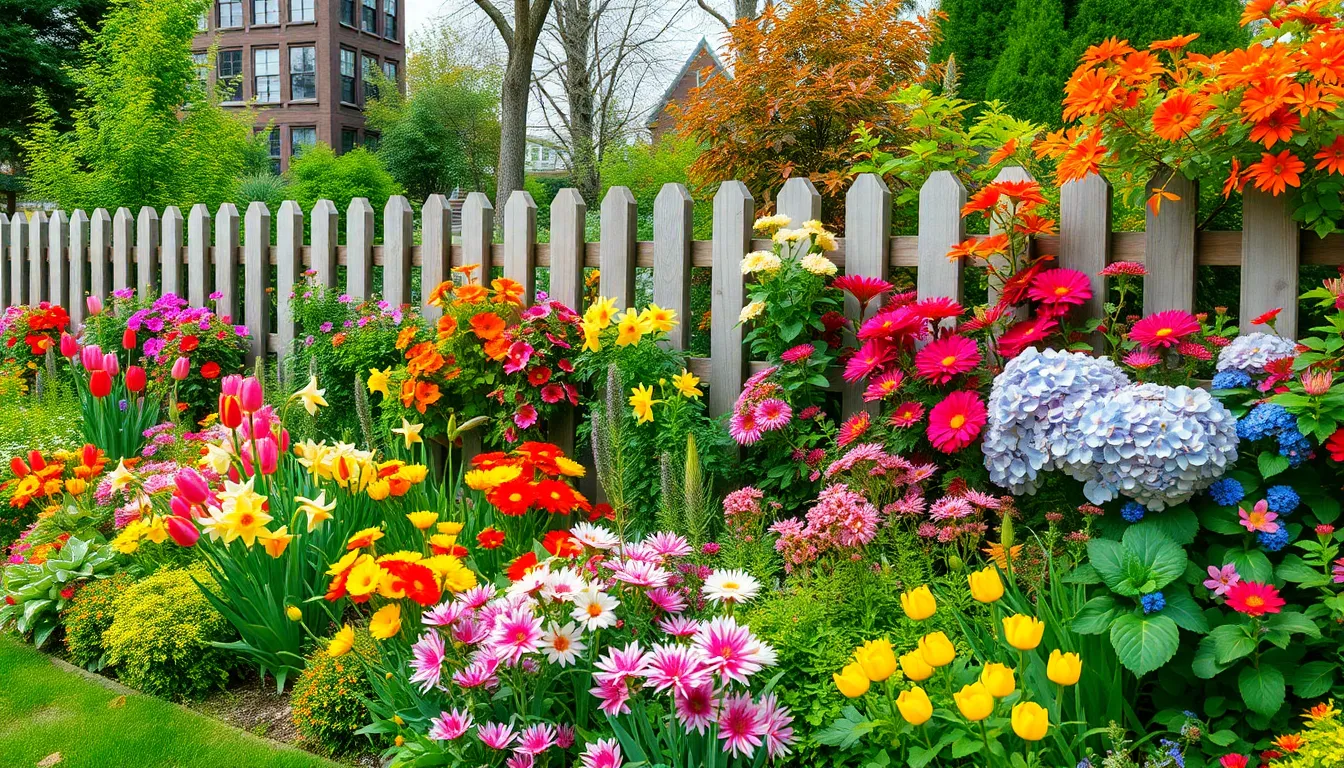
Creating a fence line that transforms throughout the year requires strategic plant selection for each season. We’ll show you how to achieve continuous color and visual interest with plants that perform at different times.
Spring Bulbs for Early Interest
Tulips bring the first splash of vibrant color to fence lines after winter’s dormancy. These reliable spring performers create dramatic displays in clustered plantings, with varieties like Darwin hybrids offering sturdy stems and bold colors that last for weeks.
Daffodils provide cheerful yellow and white blooms that naturalize beautifully along fence borders. We recommend planting different varieties with staggered bloom times to extend the flowering period from early March through late April.
Crocuses emerge as the earliest spring messengers, often pushing through snow to deliver purple, white, and yellow flowers. Their low growth habit makes them perfect for the front edge of fence plantings, where they won’t be hidden by taller plants.
Alliums add architectural interest with their spherical flower heads that rise above other spring bulbs. Purple varieties like ‘Giganteum’ create stunning focal points, while smaller species like ‘Moly’ spread naturally to form golden carpets.
Summer Annuals for Continuous Blooms
Garden phlox delivers months of fragrant flowers in shades of pink, white, purple, and red throughout the summer months. These tall perennials create excellent backdrop plants that attract butterflies and hummingbirds to fence line gardens.
Shasta daisies offer classic white blooms that provide bright contrast against dark fence materials. Their long flowering season extends from early summer through fall with regular deadheading, making them reliable workhorses for continuous color.
Bright flowering annuals like zinnias and marigolds fill gaps between perennials with non-stop blooms. We’ve found that combining these heat-loving plants creates three-season displays that remain vibrant through summer’s hottest weather.
Long-blooming perennials such as coneflowers and black-eyed Susans provide sturdy structure while delivering consistent color. These drought-tolerant options reduce maintenance needs while supporting beneficial insects and birds.
Fall Foliage Plants for Autumn Appeal
Panicle hydrangeas transition from summer whites to autumn pinks and reds, extending their visual impact well into fall. Varieties like ‘Limelight’ and ‘Fire Light’ offer color-shifting blooms that create ever-changing seasonal displays along fence lines.
Deciduous shrubs with colorful fall foliage transform fence borders into autumn showcases. We recommend selecting varieties that offer multiple seasons of interest, combining spring flowers with spectacular fall color changes.
Photinia provides glossy red new growth in spring that matures to deep green before developing bronze and red autumn tones. This evergreen shrub offers year-round structure while contributing seasonal color variations that complement changing fence line displays.
Certain maple varieties like Japanese maples create stunning focal points with their brilliant orange, red, and yellow fall foliage. These smaller trees work well at fence corners or as specimen plants that anchor seasonal plantings.
Conclusion
Transforming your fence line doesn’t have to be overwhelming when you know which plants work best for your exact needs. We’ve covered everything from fast-growing vines and evergreen privacy screens to productive edible gardens and stunning seasonal displays.
The key to success lies in matching plants to your local conditions and maintenance preferences. Whether you’re looking for low-care ground covers or show-stopping flowering perennials there’s a perfect solution waiting for your space.
Remember that the best fence line landscaping combines beauty with function. By choosing the right mix of native plants evergreens and seasonal bloomers you’ll create an outdoor space that enhances your property value while supporting local wildlife and providing years of enjoyment.
Frequently Asked Questions
What are the fastest-growing plants for fence line privacy?
Fast-growing vines like clematis, Virginia creeper, and honeysuckle are excellent choices for quick fence transformation. Clematis varieties like ‘Jackmanii’ provide colorful blooms and attract butterflies. Virginia creeper offers dense coverage with stunning fall foliage, while honeysuckle vines provide fragrant flowers and attract pollinators. These options can quickly create privacy while adding visual appeal.
Which evergreen shrubs work best for year-round privacy screening?
Arborvitae varieties like Emerald Green and Green Giant are ideal for tall screening with rapid growth and minimal maintenance. Boxwood creates elegant, structured borders adaptable to various designs. Holly shrubs provide dual-purpose privacy and natural security while supporting local wildlife. These evergreens maintain dense coverage throughout all seasons.
What flowering perennials enhance fence borders with lasting color?
Hydrangeas offer bold summer blooms and dense growth perfect for privacy. Roses provide classic elegance and fragrance in both shrub and climbing varieties. Lavender adds aromatic qualities with drought tolerance while attracting pollinators. These perennials create lasting structure with seasonal color that returns year after year.
Which low-maintenance ground cover options work well along fence lines?
Hostas thrive in shaded areas with diverse leaf shapes and colors, requiring minimal care. Daylilies excel in sunny locations with bright summer flowers and drought tolerance. Pachysandra forms dense mats in shaded areas, providing excellent erosion control. These ground covers create beautiful borders without constant upkeep.
Can I create an edible fence line garden?
Yes, foodscaping transforms fence lines into productive gardens. Berry bushes like currants, raspberries, and blueberries provide fresh fruit while serving as privacy screens. Grape vines maximize vertical space offering shade and fruit production. Low-growing herbs like thyme and oregano require minimal maintenance while providing culinary uses.
Why should I choose native plants for fence line landscaping?
Native plants are naturally adapted to local conditions, requiring minimal maintenance and water. Regional wildflowers like purple coneflower provide beauty and ecological benefits. Indigenous grasses offer erosion control, while local shrubs create wildlife habitats. Native species support local ecosystems and are more sustainable long-term.
How can I achieve year-round seasonal color along my fence?
Strategic plant selection ensures continuous visual interest throughout seasons. Plant spring bulbs like tulips and daffodils for early blooms. Add summer perennials like garden phlox and Shasta daisies for vibrant colors. Include fall-interest plants like panicle hydrangeas and deciduous shrubs with colorful autumn foliage for dynamic displays.







